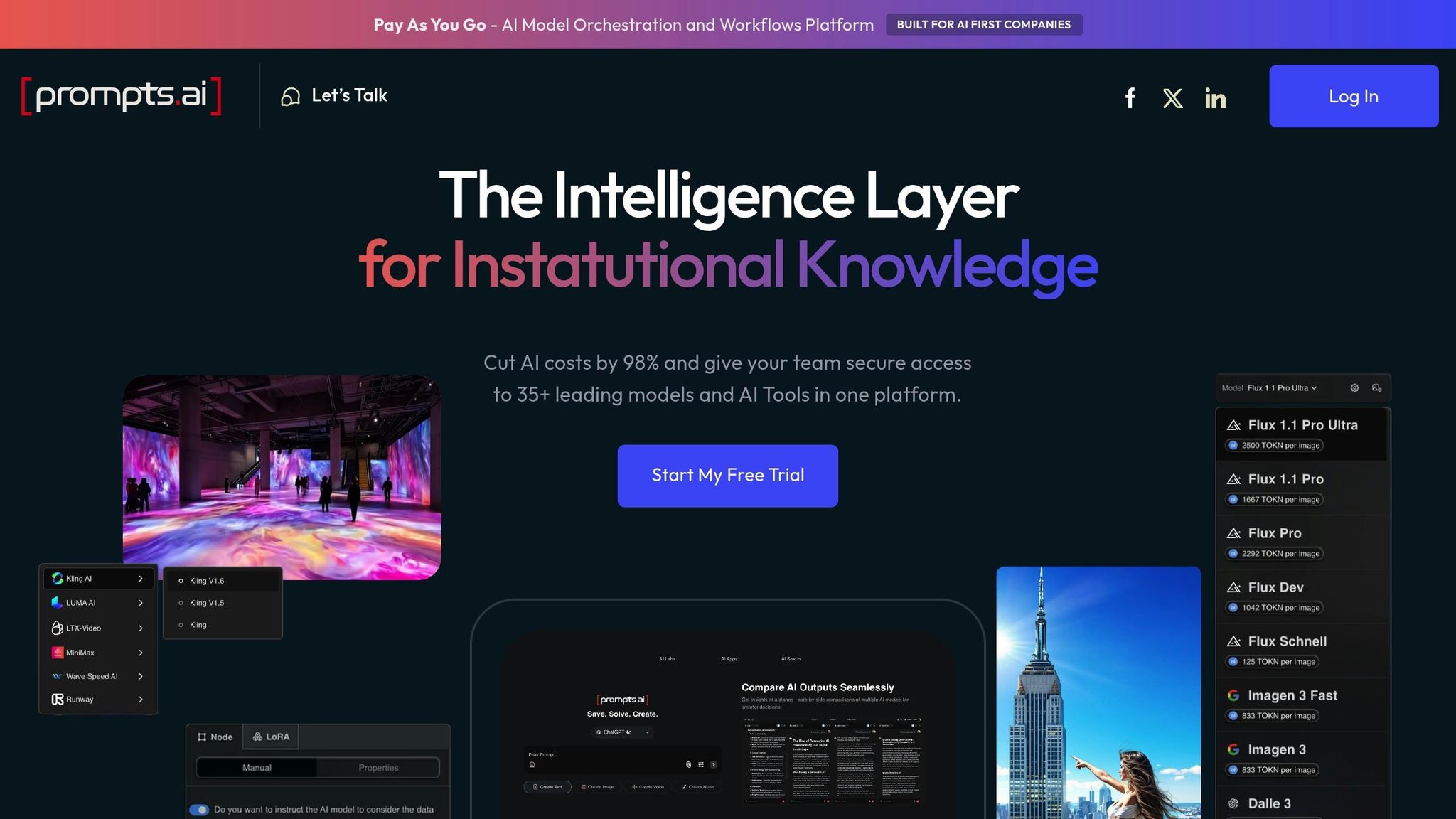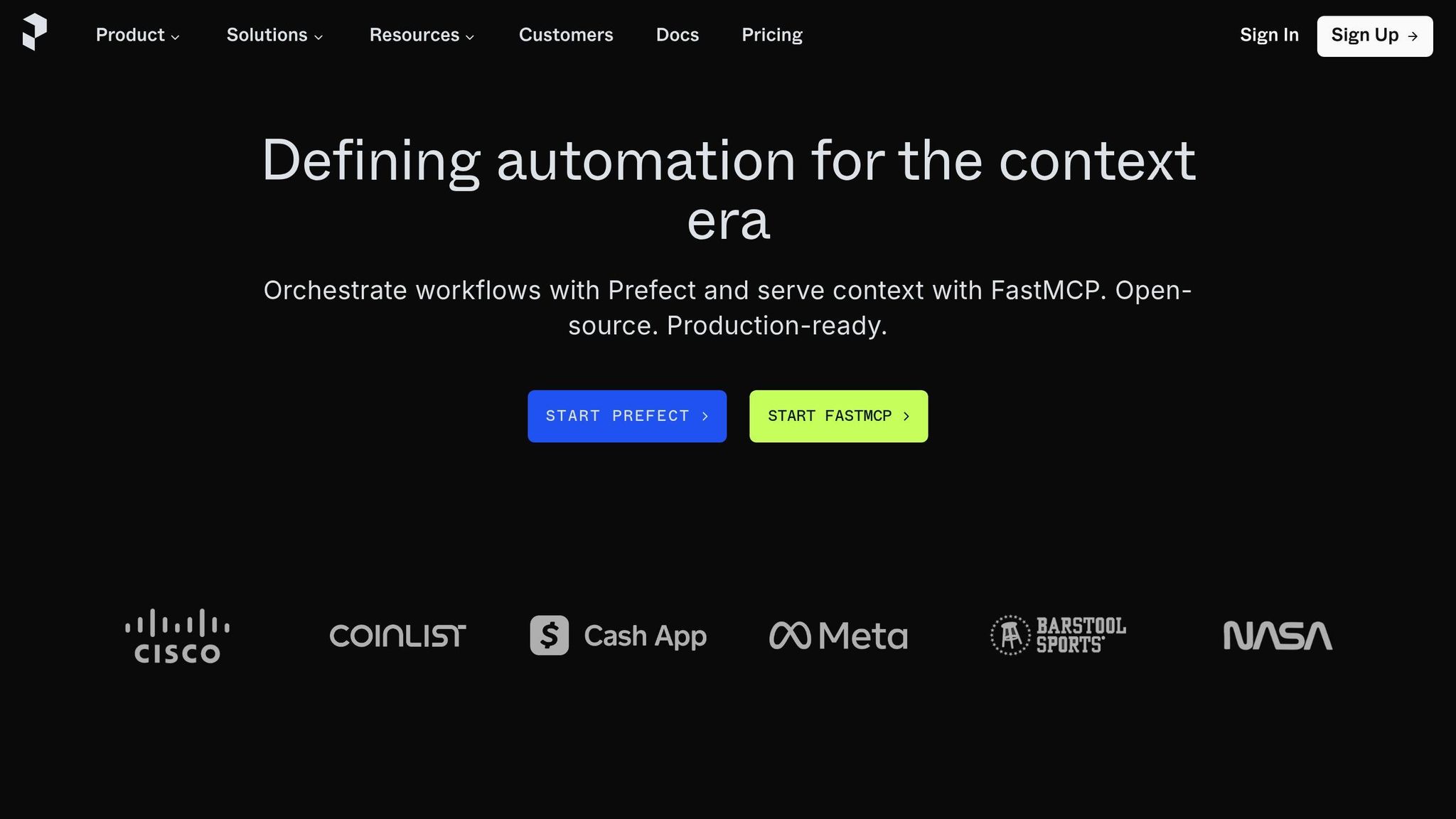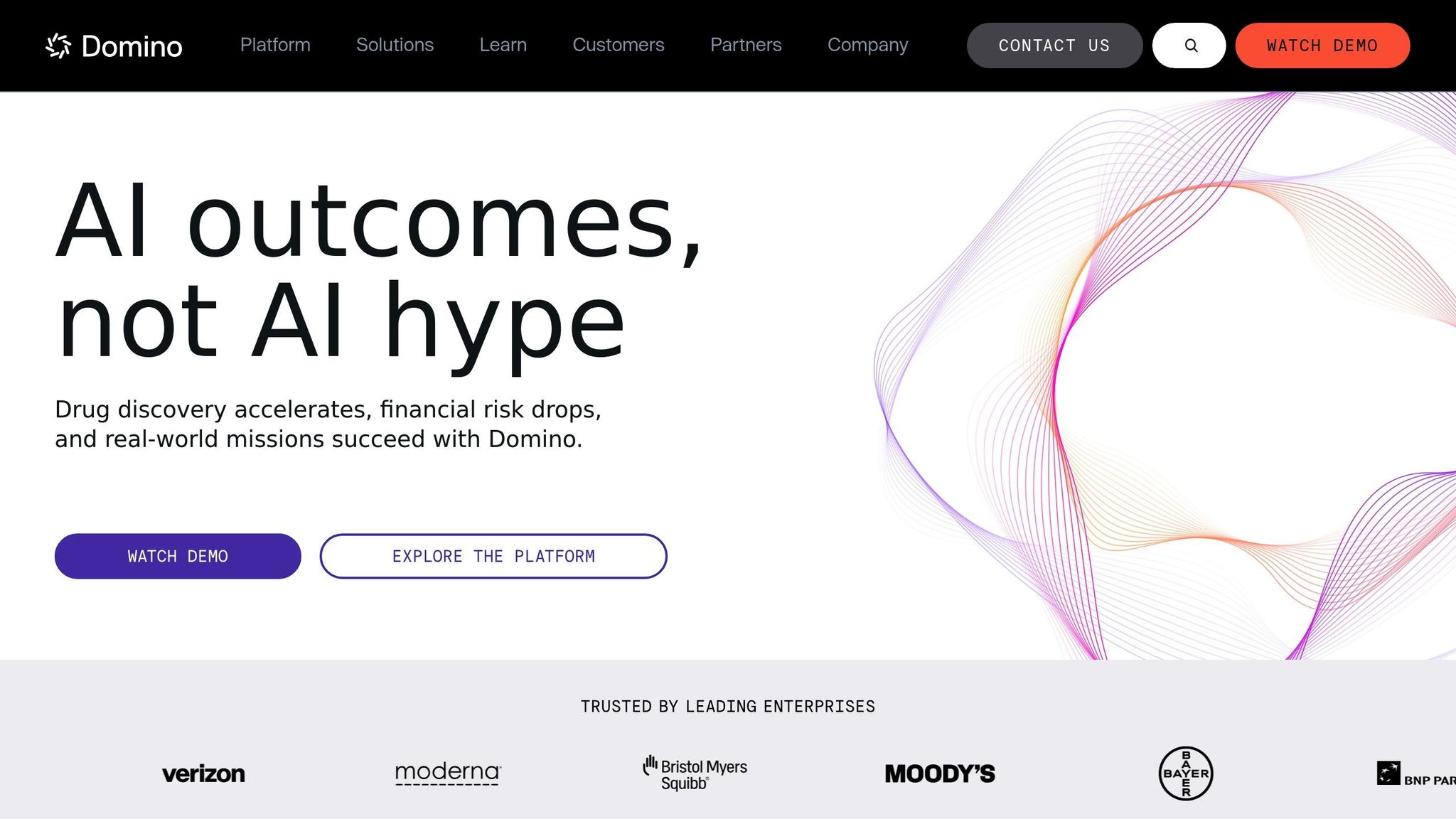
In today’s fast-moving AI landscape, orchestration platforms are critical for managing workflows, integrating tools, and scaling operations efficiently. Whether you're consolidating large language models (LLMs), automating machine learning (ML) pipelines, or optimizing costs, the right software can streamline your processes. This article breaks down the top AI orchestration platforms, highlighting their features, deployment options, and pricing to help you choose the best solution.
| Platform | Strengths | Challenges | Pricing Model |
|---|---|---|---|
| Prompts.ai | 35+ LLMs, cost savings, easy scaling | Limited to cloud deployment | Pay-as-you-go, starts at $0 |
| Kubeflow | Open-source, Kubernetes-native | Steep learning curve, DevOps-heavy | Free, infrastructure costs |
| Apache Airflow | Strong community, Python-based | Not AI-specific, GPU management | Free, cloud usage fees |
| Prefect Orion | Hybrid execution, Python API | Fewer integrations, newer platform | Free or managed subscriptions |
| DataRobot | AutoML, enterprise governance | Expensive, potential vendor lock-in | Enterprise pricing |
| Domino Data Lab | Collaboration, resource management | Resource-intensive, complex pricing | Enterprise pricing |
| Azure ML | Microsoft ecosystem, managed workflows | Azure dependency, steep learning curve | Usage-based, Azure pricing |
| Google Vertex AI | Google Cloud integration, serverless | GCP dependency, limited customization | Usage-based, GCP pricing |
Let’s explore each platform's features and strengths in detail to help you find the best fit for your AI needs.

Prompts.ai acts as an "Intelligence Layer", bringing together more than 35 top-tier AI models - including GPT-5, Claude, LLaMA, and Gemini - into one streamlined platform. Instead of managing numerous separate tools, teams can access these models through a single, secure interface that prioritizes governance and compliance.
What sets Prompts.ai apart is its ability to transform one-off experiments into scalable, repeatable workflows. Organizations can evaluate large language models side-by-side, automate processes across various departments, and maintain complete oversight of AI usage and costs. This approach has enabled businesses to slash their AI software expenses by up to 98% while significantly enhancing productivity.
Prompts.ai offers a cloud-based SaaS solution that simplifies onboarding through a user-friendly web interface and API. This eliminates the need for complicated infrastructure management, making it especially appealing to U.S. companies aiming for quick and cost-efficient implementation.
With its cloud-native framework, the platform provides automatic updates, high availability, and easy team-wide access - all without requiring dedicated IT resources for upkeep. Organizations can get started in just minutes, making it an excellent choice for businesses looking to operationalize AI without the hassle of extensive technical setup.
One of Prompts.ai's standout features is its seamless integration with leading LLMs and enterprise tools. It connects directly to major AI providers like OpenAI, Anthropic, and Google through robust APIs, while also integrating with popular business applications like Slack, Gmail, and Trello to enable automated workflows.
For instance, a U.S.-based e-commerce company used Prompts.ai to connect its CRM with large language models, streamlining customer support. This integration reduced response times and improved customer satisfaction.
The platform also supports advanced customization, including fine-tuning LoRA models and creating AI Agents that can be embedded into workflows. This level of flexibility allows businesses to tailor their AI operations to meet specific needs, going beyond standard model usage.
These integrations are supported by a scalable infrastructure that adapts effortlessly to growing requirements.
Built on a cloud-native architecture, Prompts.ai ensures elastic scaling, high availability, and low latency, delivering consistent performance even during peak demand. The system automatically manages resource allocation and load balancing, keeping workflows responsive as data volumes and user activity increase.
The platform's scalability isn't limited to technical performance - it also supports organizational growth. Teams can easily add new models, users, or workspaces without disrupting current operations, making it ideal for companies navigating rapid growth or evolving AI needs.
Prompts.ai uses a straightforward subscription-based pricing system, billed in U.S. dollars. Plans are designed around usage and team size, avoiding hidden fees or overly complex pricing structures.
For individuals, plans range from a free Pay As You Go option ($0.00/month) to the Family Plan ($99.00/month). Business plans start at $99.00 per member per month for the Core plan and go up to $129.00 per member per month for the Elite plan. Each tier includes specific allocations of TOKN credits, storage, and features.
The pay-as-you-go TOKN credit system ensures that costs align directly with actual usage, eliminating charges for unused capacity. This transparent approach makes budgeting easier while allowing businesses to scale their AI operations based on real demand. Invoices are detailed, offering a clear breakdown of TOKN credit usage.

Kubeflow is an open-source platform designed for machine learning (ML) workflows, built to run natively on Kubernetes. By leveraging Kubernetes' container orchestration and resource management capabilities, it simplifies distributed training and multi-step pipeline execution.
Kubeflow operates on Kubernetes clusters, offering deployment flexibility across various environments. It can be set up on public cloud platforms like AWS, Google Cloud, and Microsoft Azure, or within on-premises and hybrid infrastructures. Thanks to its containerized design, Kubeflow ensures portability and consistency across these diverse environments. This adaptability makes it a valuable tool for enterprises looking to standardize AI workflows across different setups.
One of Kubeflow's standout features is its multi-framework compatibility, which enables seamless integration with popular ML frameworks such as TensorFlow, PyTorch, and XGBoost. It also supports custom frameworks, making it highly versatile.
Kubeflow's extensible architecture allows for the inclusion of custom operators, plugins, and integrations with leading cloud services and storage solutions. This design enables organizations to connect Kubeflow to their existing tools without requiring significant infrastructure changes.
For instance, a large enterprise used Kubeflow to manage multiple ML projects simultaneously, running frameworks like TensorFlow alongside others. Their data science teams built pipelines to handle tasks such as data preprocessing, distributed model training on GPU clusters, and deploying the best-performing models to production. Kubeflow handled complex processes like resource allocation, versioning, and scaling in the background. This allowed teams to focus on improving models while automating retraining workflows triggered by new data. Such integration capabilities highlight Kubeflow's ability to support dynamic scaling and deliver reliable performance.
Kubeflow, built on Kubernetes, excels in scalability and performance. It offers automatic resource scaling, dynamically adjusting to workload requirements, which allows teams to prioritize model development without worrying about infrastructure.
Additionally, Kubeflow supports distributed training across multiple nodes and GPUs, ensuring that even large-scale ML tasks are executed efficiently. This makes it a powerful solution for organizations handling complex and resource-intensive machine learning workflows.

Apache Airflow is a widely-used open-source platform designed for orchestrating workflows through a Directed Acyclic Graph (DAG) structure. Originally developed by Airbnb, Airflow has become a go-to tool for managing intricate data pipelines and AI workflows.
Airflow offers several deployment methods, catering to diverse operational needs. You can install it on servers, deploy it in containers using Docker, or configure it for cloud-native environments like AWS, Google Cloud, and Azure. Managed services such as Amazon MWAA and Google Cloud Composer streamline the process by providing features like automatic scaling and integrated security. For those requiring a mix of environments, hybrid deployments are also an option.
With hybrid setups, teams can seamlessly run workflows across both on-premises and cloud environments. For instance, sensitive data can remain on-premises for secure processing, while compute-heavy AI tasks like training models are handled in the cloud. This unified approach within a single Airflow instance ensures operational flexibility and robust system integration.
Airflow boasts a rich ecosystem of operators and hooks, enabling smooth integration with a wide range of tools, databases, and machine learning frameworks.
For AI-specific workflows, Airflow works well with platforms like MLflow for tracking experiments and Apache Spark for distributed data processing. Its Python-based foundation is a natural fit for data science tasks, allowing the incorporation of custom Python scripts, Jupyter notebooks, and machine learning libraries directly into pipelines. The platform's XCom feature enhances task coordination by enabling efficient data sharing between steps in workflows, such as preprocessing, model training, validation, and deployment.
Airflow’s executor architecture ensures it can scale to meet varying workload demands. The LocalExecutor is ideal for single-machine setups, while the CeleryExecutor supports distributed, high-throughput tasks.
In Kubernetes environments, the KubernetesExecutor stands out by dynamically creating pods for individual tasks. This approach ensures resource isolation and automatic scaling, making it particularly useful for AI workloads. For example, GPU-enabled pods can handle training tasks, while standard compute resources manage data preprocessing, optimizing resource allocation.
Airflow also supports robust parallelization, with built-in retries and failure handling to ensure reliability. These features make it a dependable choice for automating AI workflows, even at an enterprise scale.
As an open-source platform, Apache Airflow itself is free to use, with costs tied only to the underlying infrastructure. Managed cloud services adopt a usage-based pricing model, charging based on factors like compute and storage. This setup allows teams to closely monitor and control resource expenses, tailoring costs to actual operational needs.

Prefect Orion simplifies the orchestration of complex workflows while offering the flexibility to adapt to various deployment needs. It’s built to make managing intricate processes more straightforward, allowing organizations to select the deployment model that aligns best with their specific requirements. Below, we’ll dive into the two main deployment options that showcase this adaptability.
Prefect provides two deployment methods tailored to meet a range of operational demands:
The decision between these two options hinges on your organization’s operational priorities and compliance considerations.

The DataRobot AI Platform offers an enterprise-level solution focused on automated machine learning and managing the entire lifecycle of AI models. However, specifics about its integration with existing AI systems or its ability to orchestrate large language models are not provided. Additionally, details on deployment options, scalability, and pricing remain unclear. While these omissions leave some questions unanswered, DataRobot continues to hold a prominent position in the enterprise AI landscape, making it a platform worth examining further during evaluations.

Domino Data Lab is designed to handle the demands of complex, large-scale AI projects, offering exceptional scalability and performance. Whether you're conducting isolated experiments or managing enterprise-wide initiatives with hundreds of data scientists and thousands of simultaneous model executions, this platform has you covered.
To tackle scalability, Domino Data Lab uses dynamic allocation to adjust computing resources based on workload demands. Its distributed framework, powered by Kubernetes orchestration, seamlessly manages resource distribution across nodes and zones. This ensures efficient handling of large-scale training and batch inference tasks. Additional features like intelligent caching, GPU/TPU acceleration, and continuous resource monitoring help improve performance while keeping computational costs in check.

Microsoft's Azure Machine Learning simplifies managing large-scale AI workflows within the Azure ecosystem. With SynapseML, it combines the power of Apache Spark and cloud data warehouses to enable seamless model deployment and large-scale analytics. This blend of distributed processing and scalable analytics solidifies Azure Machine Learning as a key tool for orchestrating end-to-end AI workflows.

Google Vertex AI Pipelines is a tool within the Google Cloud ecosystem designed to manage and streamline machine learning workflows. It offers capabilities for orchestrating AI operations, but specifics regarding deployment, integration, scalability, and pricing are best explored through the official Google Cloud documentation. For a thorough understanding and to determine how it aligns with your workflow needs, consulting these detailed resources is highly recommended.
AI orchestration platforms each bring their own set of advantages and challenges, shaping how organizations approach their AI workflows. Understanding these differences is crucial for selecting a platform that aligns with your technical needs and operational goals.
Here’s a closer look at the strengths and trade-offs of some prominent platforms:
Prompts.ai offers a standout combination of cost management and model variety. Its pay-as-you-go TOKN credit system eliminates recurring subscription fees, making it a cost-efficient choice. With access to over 35 top language models - including GPT-5, Claude, LLaMA, and Gemini - teams can streamline operations without juggling multiple vendor accounts. The built-in FinOps layer ensures real-time token tracking, while certification programs help teams build internal expertise.
Kubeflow thrives in Kubernetes-native environments where teams already have container orchestration skills. Its open-source framework allows full customization and avoids vendor lock-in. The platform supports the entire machine learning lifecycle, from experimentation to production. However, its steep learning curve and significant setup and maintenance demands can be challenging for teams without strong DevOps experience.
Apache Airflow is a trusted option for workflow orchestration, backed by a large community and a wide ecosystem of operators for diverse data sources. Built on Python, it feels intuitive for engineers and data scientists, and its web-based UI simplifies workflow visibility and debugging. While mature and well-documented, Airflow wasn’t designed specifically for AI workloads, making GPU management and model pipelines more complex.
Prefect Orion brings a modern, cloud-native approach to workflow orchestration. Its hybrid execution model allows sensitive tasks to run on-premises while leveraging cloud orchestration. The Python-based API is user-friendly, and features like automatic retries and failure handling enhance reliability. However, as a newer platform, it has fewer third-party integrations and community resources compared to more established tools.
The table below provides a summary of each platform's key strengths and weaknesses:
| Platform | Key Strengths | Primary Weaknesses |
|---|---|---|
| Prompts.ai | 98% cost savings, 35+ LLMs, real-time FinOps, enterprise security | - |
| Kubeflow | Kubernetes-native, open-source flexibility, full ML lifecycle | Steep learning curve, high DevOps overhead |
| Apache Airflow | Mature ecosystem, Python-based, strong community support | Not AI-specific, complex GPU management |
| Prefect Orion | Cloud-native, hybrid execution, intuitive Python API | Newer platform, fewer third-party integrations |
| DataRobot AI Platform | AutoML capabilities, enterprise governance, model monitoring | High cost, potential vendor lock-in |
| Domino Data Lab | Collaborative environment, experiment tracking, model deployment | Resource intensive, complex pricing |
| Azure Machine Learning | Microsoft integration, managed infrastructure, MLOps tools | Azure dependency, steep learning curve |
| Google Vertex AI Pipelines | Google Cloud integration, serverless scaling, pre-built components | GCP dependency, limited customization |
DataRobot AI Platform is a strong choice for teams needing AutoML functionality to speed up model development. With automated feature engineering and model selection, it reduces deployment times. Its enterprise-grade governance and monitoring features meet compliance needs, but high licensing fees and the risk of vendor lock-in may deter those seeking flexibility.
Domino Data Lab emphasizes collaboration, integrating experiment tracking and efficient compute sharing. While this fosters teamwork, its demanding resource requirements and intricate pricing structure can complicate cost management.
Cloud-native platforms such as Azure Machine Learning and Google Vertex AI Pipelines simplify operations by offering managed infrastructure and tight integration with their respective ecosystems. These platforms reduce the need for maintaining orchestration infrastructure and provide strong security features. However, the trade-off lies in dependency on specific cloud providers.
When assessing these platforms, consider your team’s technical expertise, current infrastructure, budget, and long-term goals. The right choice will balance immediate needs with scalability, cost efficiency, and operational flexibility.
Selecting the right AI orchestration platform depends on aligning your organization's goals with the specific strengths of each option. The market includes everything from all-encompassing enterprise platforms to tools focused on specialized workflows, catering to a variety of operational needs.
For teams prioritizing cost efficiency and access to a wide range of models, Prompts.ai stands out with its pay-as-you-go TOKN system and access to over 35 leading language models. Its built-in FinOps layer provides real-time cost tracking, making it especially useful for managing AI budgets across multiple projects. That said, each platform serves unique operational contexts.
For example, Kubeflow integrates seamlessly with Kubernetes but requires advanced DevOps expertise. Similarly, Apache Airflow offers a well-established Python ecosystem but presents challenges in GPU management. While these open-source tools are flexible, they demand significant technical proficiency to implement and maintain effectively.
Meanwhile, managed solutions like Azure Machine Learning and Google Vertex AI Pipelines reduce infrastructure overhead but tie organizations to specific cloud ecosystems. These platforms are ideal for teams already invested in Microsoft or Google cloud services.
Enterprise-grade solutions such as DataRobot and Domino Data Lab offer advanced features tailored to AutoML and team collaboration. However, they come with higher costs and potential vendor lock-in, requiring careful evaluation of long-term benefits and resource allocation.
Ultimately, success in AI orchestration lies in selecting platforms that match your team's expertise, infrastructure, and scalability requirements. Starting with flexible pricing models and broad model access can help you experiment and scale without heavy upfront investments. This approach ensures your organization can build effective AI workflows that drive measurable impact while maintaining the flexibility to adapt as needs evolve.
When choosing an AI orchestration platform, it's essential to consider several critical aspects like integration options, automation capabilities, and security measures. Look for a platform that easily connects with your current systems, supports large language models, and provides strong automation features to simplify workflows.
Equally important are scalability and adaptability, ensuring the platform can grow alongside your organization’s evolving demands. A straightforward interface and clear governance tools can make adoption and management smoother. By aligning these features with your organization's objectives, you can select a platform that boosts efficiency and streamlines AI-powered processes.
Cloud-native AI platforms are built to deliver scalable performance and cost control, making them a practical choice for businesses across the spectrum. With many offering pay-as-you-go pricing, you can keep expenses in check by only covering the resources you actually use. These platforms are also equipped to manage extensive AI workflows, scaling seamlessly to meet increasing demands - all without the need for hefty upfront infrastructure investments.
When considering AI orchestration solutions, take the time to assess how well a platform fits your workflow requirements, integration needs, and financial plan. Since scalability and pricing models can differ, focus on finding a solution that strikes the right balance between performance and affordability for your specific goals.
Open-source AI orchestration platforms, such as Kubeflow and Apache Airflow, provide robust capabilities but come with their own set of challenges. One of the biggest obstacles is the steep learning curve. These platforms often demand a deep understanding of coding, infrastructure management, and AI workflows, which can make them less approachable for teams lacking specialized technical skills.
Another significant issue is the complexity of integration. While these tools are highly adaptable, configuring them to work smoothly with other systems - like large language models or proprietary software - can be both time-consuming and technically demanding. Furthermore, maintaining and scaling these platforms requires ongoing expertise and resources, which can be a burden for smaller teams or organizations operating on tight budgets.
Even with these challenges, open-source platforms remain an appealing option for organizations that prioritize flexibility and have the necessary resources to handle their setup and upkeep effectively.


